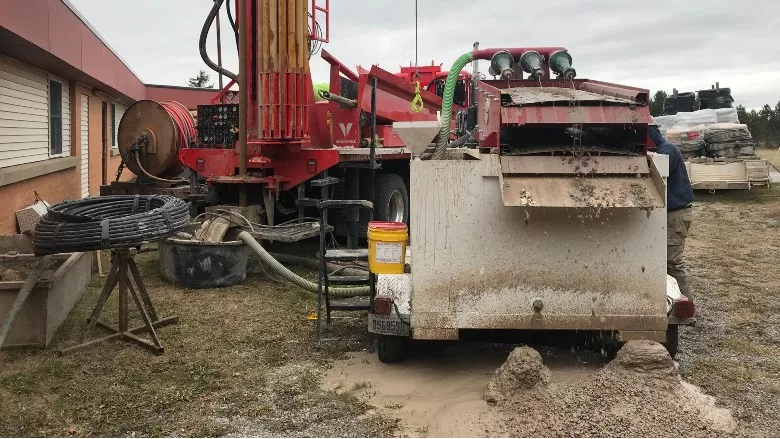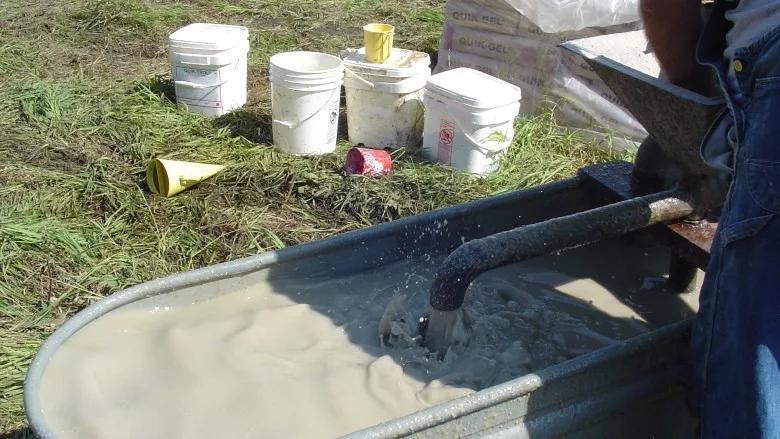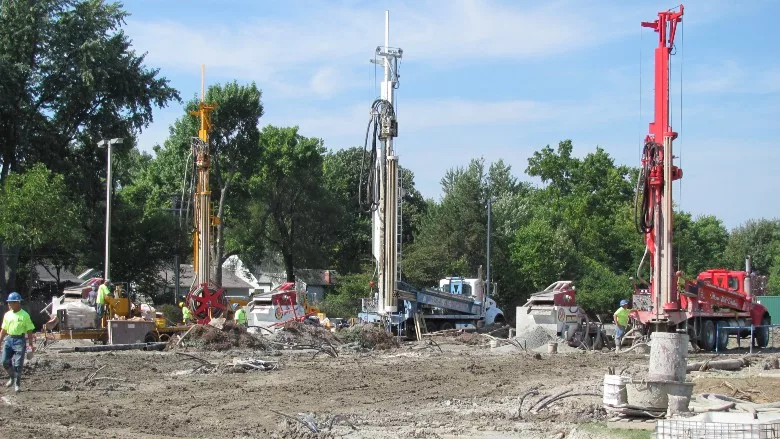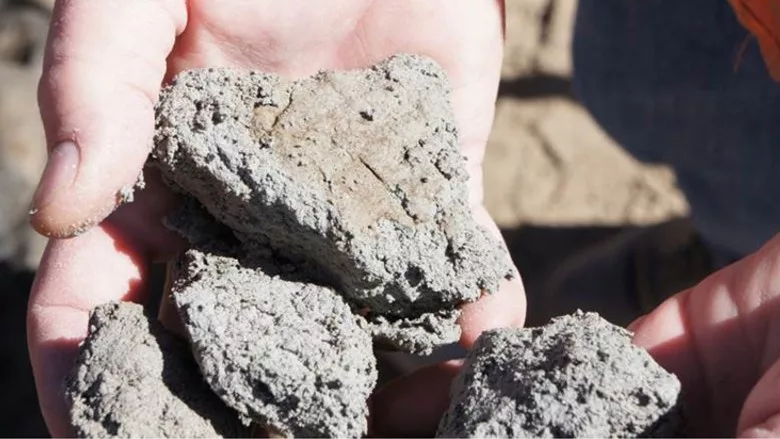Best Practices, Common Mistakes for Drilling, Disposal Plans
The 3 Basic Components of a Drilling Fluids, Waste System

Before you even turn a bit, get a handle on your three-part system: active, dirty and waste.
Source: Brock Yordy

Three-part systems require a pre-mix tank independent of active and dirty systems. The pre-mix tank gives fluid additives time to yield while not impacting the active system.
Source: Brock Yordy

Larger industrial projects likely require regular disposal due to the amount of waste multiple rigs can generate.
Source: Brock Yordy

The goal of a proper waste management and disposal plan? To generate as much semi-dry material as possible.
Source: Brock Yordy
Hey, driller! Yeah, I am talking to you! Don’t start with Part 3 of this series on managing and disposing of drilling fluids and drilling waste. You need to start from the beginning with Part 1. As drillers, we love to skip right to the final chapter, which we believe is the only information we need. This article is a companion to Part 1 and Part 2, and assumes that we as a drilling team have solved those issues before the first turn of the bit.
The goal of a proper waste management and disposal plan is to generate as much semi-dry material as possible. The only way to achieve that goal is to create and execute that plan from start to finish. A good plan sets maximum waste production limits, with room for flexibility to deal with unknown downhole conditions that could impact our program. However, that flexibility should not triple the final waste production, but ensure the team can adjust throughout the project. Keep your program simple and executable.
The 3-Part System
I start my program by identifying and designating the working fluid and waste streams generated onsite. The best practice utilizes a three-part system: active, dirty and waste.
- The active system is the total volume of fluid required to maintain drilling while preventing equipment or downhole damage.
- The dirty system is fluid with an undesirable solids concentration beyond 3.7% or 8.8 pounds per gallon. Dirty fluid is removed from the active system by a method of solids control, processed back to a solids content below 3.7%, and returned to the active system.
- The high-solids portion of the fluid becomes the waste stream.
The three-part system can be as simple as a newly mixed multi-sectioned 300-gallon mud pan pumped downhole and separated by cones and shovels at the front of the pit. Or as complicated as a 10,000-gallon active system with a 5000-gallon solids control unit and waste pit. Breaking the system into three parts helps us understand how much volume we can effectively utilize and how much gets separated into waste. Finally, understanding this life cycle and the balance of active and waste streams gives the driller insight into how much fluid loss stems from downhole conditions. The biggest impact on the success of the plan and system comes from overwhelming the system due to both desirable and undesirable solids, causing us to generate more waste by creating unsalvageable fluid.
Common Mistakes in the 3-Part System
The common mistakes that generate more waste start with creating an active system too small to handle total circulating volume, plus solids separation and loss from waste generation. The system gets out of balance. It cannot handle the solids loading from a rate of penetration that the system isn’t able to take. Generally, that causes an increase in percent solids by a decrease in the total fluid volume. Therefore, the most common mistake is adding more volume in pure water to maintain drilling rates.
Once the fluid properties start to break down due to dilution and solids loading, the next common mistake involves mixing new drilling fluid additives directly into the active system. A three-part system requires a pre-mix tank independent of the active and dirty systems. The pre-mix tank allows fluid additives time to yield for full effectiveness while not impacting the active system. Adding bentonites and polymers directly to an active system full of solids and starting to break down by dilution creates a dense, viscous fluid ineffective at drilling. The good news? That fluid will evacuate itself by blinding the shaker screens and flowing into the waste pit.
Dumping the active system and starting over add to waste disposal and the bottom line. However, times come when the cost-effective operator has to dump and start over rather than try to recover a solids-laden system. The plan and system must be effective in their ability to maintain a low-solids drilling fluid and create semi-dry solids.
Disposal of the System
Now that we have created a plan and system, what do we do with all the liquid and solid waste generated onsite? If it’s a small project with less than 10 cubic yards, it is easy to wait until the end. A production geothermal project with multiple rigs generating a combined 50 cubic yards of waste per day would, advisably, want to utilize a daily disposal plan. Let’s start by focusing on the 3-part system and how to break down each part into re-useable or disposable.
If the active system has maintained the desired drilling fluid properties and a solids content below 3.7%, the operators can pump it to a holding tank for reuse. When the fluid can’t be reused but has a low viscosity of 50 seconds per quart or lower, it is a perfect candidate for being broken out by a flocculent or coagulant. Those materials create a reaction that breaks apart the solids while simultaneously creating a low-solids effluent. You can utilized the effluent to create new drilling fluids (among other uses). Remember that, although the fluid portion appears transparent and has low solids, it is not the same as water. It will contain any impurities encountered while drilling, along with residual polymers that, when reused to make bentonite-based drilling fluid, can bind up in the mud making them inert.
Collaborate with your trusted mud engineer and design a solidification program for disposal that works for your project. A great mud engineer can teach you how to use the least amount of material for the best results.
Next, the concentrated solids created by breaking out of the active system, and all solids separated by the solids control unit, require time to dry and become semi-rigid. This storage area or pit needs to be in an area with direct sunlight and little to no runoff. Often, waste pits or slurry ponds become catch basins for runoff and rain. With today’s extreme rain events, we want that pit covered when it isn’t getting direct sunlight.
Finally, the slurry ponds that are partially solids and liquids are perfect candidates for superabsorbents and solidifiers. Drillers have plenty of options on the market, some more cost-effective than others. Remember, as a driller, you are good at turning drilling fluids into a giant pit of viscous solids with liquid PHPAs, green cement and lime. These simple options can appear to help. However, those additives fall short versus engineered solutions when the professionals come in to do a TCLP (Toxicity Characteristics Leaching Procedure) test and paint test to determine the waste material’s moisture content. Collaborate with your trusted mud engineer and design a solidification program for disposal that works for your project. A great mud engineer can teach you how to use the least amount of material for the best results. A good absorbent or solidification material works best with high-solids waste.
The best solution involves designing a system that utilizes mechanical solids control to maintain a waste creation limit. Disposal afterward requires proper separation during drilling into the active system and dirty system. That often can be aided by mechanical disposal units like weir tanks, filter presses and centrifuges combined with dispersants or flocculants. The lifecycle ends with reusing the effluent and concentrating the solids into dried material.
Looking for a reprint of this article?
From high-res PDFs to custom plaques, order your copy today!





